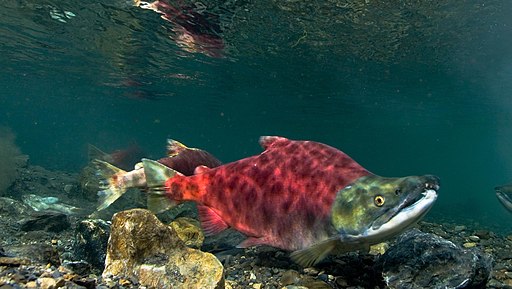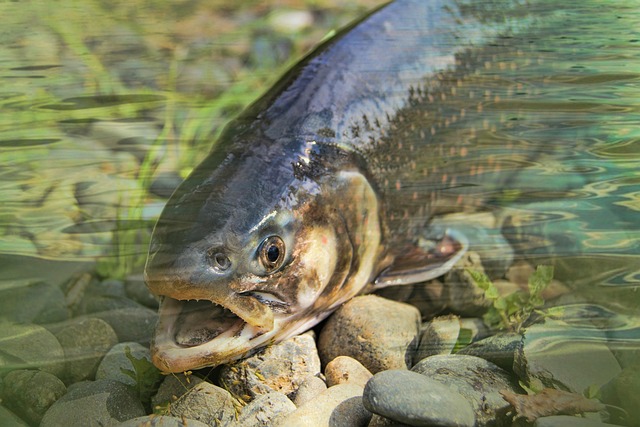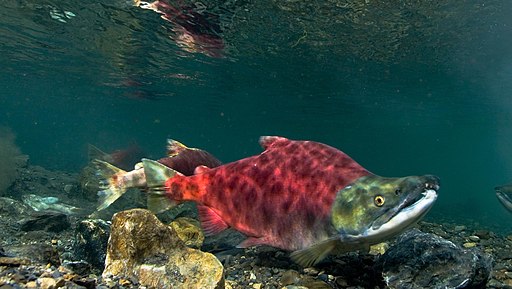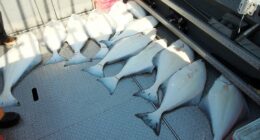Salmon and trout are both freshwater fish but differ in size, life cycles, and habitat preferences, with salmon often being larger and anadromous.
TL;DR Salmon Vs. Trout
Salmon is known for its robust flavor, firm texture, and rich pink or orange flesh. It is a migratory fish that spends part of its life in freshwater rivers before heading out to the open ocean. Trout, on the other hand, tends to have a milder taste with delicate white or pale pink flesh. They can be found in both lakes and streams.
What is Salmon

Salmon, a prized fish known for its vibrant pink flesh and rich flavor, is a species that belongs to the Salmonidae family. This remarkable creature can be found in both freshwater and saltwater environments, making it incredibly adaptable. One of the most iconic features of salmon is its ability to migrate long distances during spawning season, defying all odds as it navigates against strong currents and obstacles.
Salmon come in different varieties such as Chinook (also known as King), Coho (Silver), Sockeye (Red), Pink, and Atlantic salmon. Each type has its own unique characteristics and taste profiles. They are not only cherished by anglers but also highly sought after by seafood lovers around the world.
Salmon are valued not only for their delicious taste but also for their impressive nutritional value. Packed with omega-3 fatty acids, high-quality protein, vitamins D and B12, selenium, and other essential nutrients – consuming salmon regularly can contribute to improved heart health, brain function, and overall well-being.
In terms of sustainability and environmental impact concerns surrounding farmed salmon have been raised due to potential pollution from waste buildup or escapees impacting wild populations But efforts are being made across the industry to minimize these impacts through responsible farming practices
What is Trout?

Trout, a popular freshwater fish, is known for its delicious taste and vibrant color. There are several different species of trout, including rainbow trout, brook trout, brown trout, and lake trout. Each species has its unique characteristics that make it distinct.
Rainbow Trout
Rainbow trout are perhaps the most well-known type of trout. They have a distinctive pinkish stripe running along their sides and can vary in color from silver to dark green or blue.
Brook Trout
Brook trout are native to Eastern North America and are often found in cold mountain streams and lakes. They have a beautiful array of colors ranging from olive green to deep red with scattered white spots on their back.
Brown Trout
Brown trout have an elongated body with black spots scattered across their sides. This species is highly adaptable and can survive in both rivers and lakes.
Lake Trout
Lake trout are typically found in large freshwater lakes throughout North America. They tend to be larger than other types of trouts and can reach lengths up to 3 feet long!
Salmon Vs. Trout – Key differences
| Aspect | Salmon | Trout |
|---|---|---|
| Family | Part of Salmonidae family. | Also part of Salmonidae family. |
| Habitat | Anadromous, migrate between freshwater and saltwater. | Primarily freshwater dwellers, although some species live in both. |
| Size | Typically larger, with some species exceeding 30 inches. | Smaller on average, with most species ranging from 12 to 20 inches. |
| Coloration | Varies by species and life stage, but often more silvery in the ocean. | Diverse coloration, including the distinctive rainbow trout with a pink stripe. |
| Life Cycle | Spawn in freshwater streams and migrate to the ocean; return to spawn. | Complete their entire life cycle in freshwater or occasionally in brackish water. |
| Diet | Carnivorous, with a diet of fish, insects, and other aquatic organisms. | Carnivorous, feeding on aquatic insects, smaller fish, and crustaceans. |
| Breeding Behavior | Often die after spawning. | Some species die after spawning, while others can spawn multiple times. |
| Geographic Range | Found in both North Atlantic and Pacific Oceans. | Widely distributed in North America and Europe. |
Salmon Vs. Trout – Appearance and Physical Characteristics
Salmon
- Coloration: The coloration of salmon varies depending on species, life stage, and habitat. When in freshwater, they typically have a more vibrant appearance with shades of red, pink, or orange. In the ocean, they tend to be more silvery. During spawning, many salmon develop pronounced colors and patterns, such as the bright red of sockeye salmon or the distinctive hump of male pink salmon.
- Size: Salmon are known for their larger size, with some species like Chinook salmon reaching lengths exceeding 30 inches and weights over 30 pounds. Coho salmon and Atlantic salmon are also relatively large.
- Body Shape: They have streamlined bodies built for fast swimming. Their bodies are muscular and well-suited for long migrations.
- Fins: Salmon have distinct dorsal and anal fins, and their tails are usually forked.
- Spawning Changes: During spawning, male salmon often develop a pronounced hooked jaw (kype) and more vibrant colors. Female salmon prepare a redd (nest) in the substrate where they lay their eggs.
Trout
- Coloration: Trout, like salmon, display diverse coloration. Rainbow trout are known for their pink or red stripe that runs along their sides. Brook trout often have vibrant colors and distinctive patterns of red dots surrounded by blue halos. Brown trout tend to be brownish with scattered red spots.
- Size: Trout are generally smaller than most salmon species. Depending on the species, they typically range from 12 to 20 inches in length, though some individuals can grow larger.
- Body Shape: Like salmon, trout have streamlined bodies, but they are generally smaller and more slender.
- Fins: Trout have similar dorsal and anal fins, and their tails are usually squared or slightly forked.
- Spawning Changes: During spawning, male trout may develop more vivid colors and slight changes in body shape, but they don’t typically develop the pronounced kype seen in some male salmon.
Salmon Vs. Trout – Habitat and Distribution
Habitat
Salmon
- Freshwater and Saltwater Migration: Salmon are known for their anadromous life cycle, which means they migrate between freshwater and saltwater habitats. They are born in freshwater streams, migrate to the ocean to grow and mature, and then return to freshwater to spawn.
- Spawning in Streams: Salmon return to the same streams or rivers where they were born to spawn. They typically lay their eggs in gravel beds in freshwater.
Trout
- Freshwater Dwellers: Trout are primarily freshwater fish and do not undertake the extensive ocean migrations of salmon. They spend their entire lives in freshwater habitats, which can include rivers, streams, lakes, and ponds.
- Spawning in Freshwater: Trout also spawn in freshwater environments, laying their eggs in gravel beds in rivers or streams.
Distribution
Salmon
- North Atlantic and Pacific Oceans: Salmon have a broader geographic distribution, with various species found in both the North Atlantic and North Pacific Oceans.
- Specific Regions: Different species of salmon are associated with specific regions. For example, Chinook salmon are often found in the Pacific Northwest, while Atlantic salmon are native to the North Atlantic.
Trout
- North America and Europe: Trout species are widely distributed in North America and Europe, with several native and introduced species.
- Variety of Habitats: Trout can inhabit a variety of freshwater habitats, from cold, fast-flowing mountain streams to slower-moving rivers and deep, clear lakes.
While both salmon and trout are freshwater fish that share a preference for freshwater habitats and similar spawning behaviors, salmon are known for their unique anadromous life cycle, involving migrations between freshwater and saltwater environments, while trout primarily remain in freshwater throughout their lives.
The distribution of salmon is often linked to specific oceanic regions, while trout species can be found in various freshwater habitats across North America and Europe.
Salmon Vs. Trout – Nutritional Value and Health Benefits
Salmon
- Omega-3 Fatty Acids: Salmon is renowned for its high levels of omega-3 fatty acids, particularly EPA (eicosapentaenoic acid) and DHA (docosahexaenoic acid). These fatty acids are known for their heart-healthy benefits, including reducing the risk of cardiovascular diseases, improving cholesterol levels, and reducing inflammation.
- Protein: Salmon is an excellent source of high-quality protein, providing all essential amino acids necessary for tissue repair and muscle growth.
- Vitamin D: Salmon is one of the few natural food sources of vitamin D, which is essential for bone health, immune function, and overall well-being.
- B Vitamins: It is rich in B vitamins such as B12, niacin, and B6, which are essential for metabolism, nerve function, and red blood cell production.
Trout
- Omega-3 Fatty Acids: Trout also contains omega-3 fatty acids, though typically in slightly lower amounts than salmon. It is still a good source of heart-healthy fats.
- Protein: Like salmon, trout is an excellent source of protein, providing the body with essential amino acids.
- Vitamins: Trout contains various vitamins, including B vitamins (B6, B12, niacin), which are important for metabolism and overall health.
- Minerals: Trout is a source of essential minerals such as phosphorus, selenium, and potassium, which play various roles in maintaining health.
Both salmon and trout can contribute to a heart-healthy diet due to their omega-3 fatty acids content.
Choosing either fish can be beneficial for cardiovascular health, brain function, and overall well-being. The specific nutritional content can vary depending on the species, preparation methods, and cooking techniques used.
It’s also important to consider the source of the fish, as wild-caught fish often have slightly different nutrient profiles compared to farm-raised varieties.
Salmon Vs. Trout – Sustainability and Environmental Impact
Salmon
- Wild Salmon: Wild-caught salmon is generally considered more sustainable because it involves harvesting fish from their natural habitats. However, the sustainability of wild salmon populations can vary depending on the specific species and region.
- Farmed Salmon: Farming practices for salmon can have environmental concerns. Some salmon farms have been criticized for potential issues like disease outbreaks, water pollution, and the use of antibiotics and pesticides. However, sustainable aquaculture practices, such as those certified by organizations like the Aquaculture Stewardship Council (ASC), aim to minimize these negative impacts.
- Overfishing: Overfishing of certain salmon populations, especially in the past, has led to declines in some wild salmon stocks. Sustainable fishing practices and regulations are now in place to address this issue.
Trout
- Wild Trout: The sustainability of wild trout populations can vary by species and region. Some trout populations face threats from habitat destruction, pollution, and invasive species, while others are more stable.
- Farmed Trout: Trout farming generally has a lower environmental impact compared to salmon farming. Trout are often raised in freshwater, which can reduce some of the concerns associated with salmon farming, such as disease transmission and effluent discharge.
- Overfishing: Overfishing of certain trout species can occur in regions with high demand for sportfishing. Regulations and sustainable management practices help address this issue.
Both salmon and trout have sustainability and environmental considerations, but the specific impact can vary based on factors like species, location, and production methods.
To make environmentally conscious choices, consumers can look for certifications such as the Marine Stewardship Council (MSC) for wild-caught seafood and the ASC for responsibly farmed seafood.
Additionally, choosing sustainably sourced or farmed options can help reduce the environmental impact of both salmon and trout consumption.
Image Credits
Featured Image By – Milton Love, Marine Science Institute, University of California, Santa Barbara, CA 93106, Public domain, via Wikimedia Commons
Image 1 By – Milton Love, Marine Science Institute, University of California, Santa Barbara, CA 93106, Public domain, via Wikimedia Commons
Image 2 By – Barbara Jackson from Pixabay









